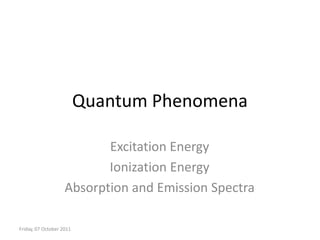
Energy levels and absorption spectra
- 1. Quantum Phenomena Excitation Energy Ionization Energy Absorption and Emission Spectra Thursday, 18 October 2007
- 2. Energy Levels in the atom As we considered, the electrons in the atom can only occupy quantized orbits, i.e. energy levels. All electrons prefer to be in the lowest (unoccupied) energy level (lowest potential energy). That is why an electron at a higher energy level eventually falls in a lower level releasing a photon. We say there is a potential well in the atom where the top of the well is at zero potential and the other energy levels are at negative potential. The ground level will be at the lowest potential energy E = 0 eV E = -1.51 eV Higher Energy Levels E = -3.40 eV Ground State E = -13.61 eV
- 4. The atom is left with one less electron in its electron cloud, so it becomes a positive ion
- 5. The energy needed for this jump is called IONIZATION ENERGYIonization Energy is the energy required to cause an electron to escape from the atom
- 7. Heating the metal (thermionic emission)
- 8. A photon with just the right energy can hit an electron giving its energy for the electron to jump to the next energy levelThe energy of the photon must be exactly the same as the energy gap between the two level
- 11. Excitation Energy In what region of the EM spectrum is the wavelength from the previous question? U.V. What energy photon would you need to ionize the atom? DE = 13.61 – 0 = 13.61 eV E = 0 eV E = -1.51 eV E = -3.40 eV E = -13.61 eV
- 12. Hydrogen Emission Spectrum Hydrogen is the simplest atom and so are its energy levels. When its only electron is excited to higher states, it can fall back to lower energy levels to emit different photons E = 0 eV E = -0.85 eV E = -1.51 eV E = -3.40 eV 1st excited state Balmer Series Ground State E = -13.61 eV Lyman Series
- 14. In the Balmer Series the “relaxation” of the electron produces emission of visible light photonsHydrogen Emission Spectrum
- 15. Emission Spectra When the electrons of an atom are exited they can jump to higher energy levels, if the energy provided is just right to make the jump. When they jump back down a photon of energy hf = E1 – E2 is emitted. That is why an atom will emit only light with wavelength (i.e. colour) characteristic of the energy levels in the atom. Click on each energy level to reveal the emission spectrum of hydrogen
- 18. Absorption Spectra and Stars We can study absorption spectra from stars to understand their composition. By looking at the Sun’s absorption spectrum can you tell which element is most abundant? Sun’s Absorption Spectrum Hydrogen Absorption Spectrum Hydrogen is the most abundant element in the Sun. In fact, the darkest lines in its spectrum match the wavelengths of the absorption spectrum of hydrogen.
- 19. The atom and energy levels A photon with energy hf = E1 – E2 hits the e-, which is exited to the next energy level. Electron: atomic particle orbiting around the nucleus. –ve charge and mass 1/1800 of a proton Neutron: neutral particle inside the nucleus. Different no of neutrons for the same element make different ISOTOPES of that element e- falls to a lower level and a photon with energy hf = E1 – E2 is released. Ground level: lowest energy state possible for the electrons. Electrons tend to fill this level 1st and “fall” in it after being exited. Proton: equal and opposite charge as e-. Slightly less mass than a neutron. Proton no: it tells the no of protons (and also electrons) in the atom. This no is a property of the element, so the atomic no tells what element the atom is. Nucleon no: given by the sum of no of protons and no of neutrons. Using this no you can identify the different isotopes of the same element. Higher energy levels: when not completely filled with e-, they can “host” exited e-. Click on different areas to reveal their properties E1 E2 7 Li e- falls back to ground level hf = E1 – E2 hf = E1 – E2 Exited e- jumps energy gap 3
